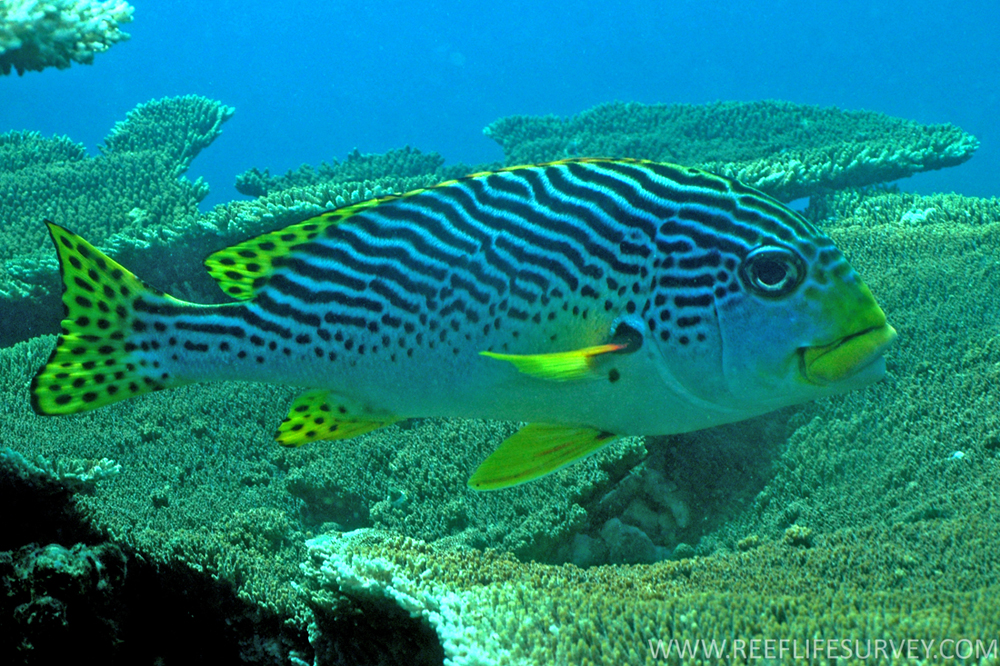Oblique-banded Sweetlips, Plectorhinchus lineatus (Linnaeus 1758)
Other Names: Diagonal-banded Sweetlips, Goldman's Sweetlips, Lined Blubber-lips, Lined Sweetlips, Many-lined Sweetlips

An Oblique-banded Sweetlips, Plectorhinchus lineatus, at Lizard Island, Great Barrier Reef, Queensland. Source: Graham Edgar / Reef Life Survey. License: CC by Attribution
Summary:
A pale grey sweetlips fading to white below, with yellowish lips, diagonal black stripes on the upper sides (sometimes broken up into spots), yellow dorsal, anal and caudal fins with black spots, and yellow pectoral and pelvic fins with a red anterior blotch.
Juveniles and subadult fish have black horizontal stripes along the body that become increasingly diagonal with growth.
Juveniles and subadult fish have black horizontal stripes along the body that become increasingly diagonal with growth.
Cite this page as:
Dianne J. Bray, Plectorhinchus lineatus in Fishes of Australia, accessed 27 Jun 2025, https://fishesofaustralia.net.au/Home/species/457
Oblique-banded Sweetlips, Plectorhinchus lineatus (Linnaeus 1758)
More Info
|
Distribution |
Known in Australian waters from Scott Reef, WA (14°03'S), Ashmore Reef, Timor Sea (12°15'S) and from the northern Great Barrier Reef south to the Capricorn Group, QLD, and to the Gold Coast Seaway in southern Queensland. Found elsewhere in the tropical east-Indo-west Pacific. Inhabits coastal and seawards reefs and lagoons to a depth of 35 m. Generally nocturnal - small groups are often seen resting out in the open during the day. |
|
Features |
Meristic features: Dorsal fin XII-XIII, 18-20; Anal fin III, 7-8; Pectoral fin 16-18; Gill rakers 7-9 + 18-21; Lateral line scales 53-58. Body depth (adult) 2.6-2.9 in SL; caudal fin of adults truncate, rounded in juveniles. |
|
Feeding |
Nocturnal carnivore - preys on benthic invertebrates on open sand flats and seagrass beds. |
|
Species Citation |
Perca lineata Linnaeus, 1758, Systema Naturae 1: 293. Type locality unknown. |
|
Author |
Dianne J. Bray |
Oblique-banded Sweetlips, Plectorhinchus lineatus (Linnaeus 1758)
References
Allen, G.R. 1997. Marine Fishes of Tropical Australia and South-east Asia. Perth : Western Australian Museum 292 pp. 106 pls.
Allen, G.R. & Erdmann, M.V. 2012. Reef fishes of the East Indies. Perth : Tropical Reef Research 3 vols, 1260 pp.
Coleman, N. 1981. Australian Sea Fishes North of 30°S. Lane Cove, NSW : Doubleday Australia Pty Ltd 297 pp.
Gloerfelt-Tarp, T. & Kailola, P.J. 1984. Trawled Fishes of Southern Indonesia and Northwest Australia. Jakarta : Dir. Gen. Fish. (Indonesia), German Tech. Coop., Aust. Dev. Ass. Bur. 406 pp. ( as Plectorhinchus goldmanni and P. lineatus)
Grant, E.M. 1975. Guide to Fishes. Brisbane : Queensland Government, Co-ordinator General’s Department 640 pp. (as Plectorhinchus goldmanni)
Grant, E.M. 1991. Fishes of Australia. Brisbane : EM Grant Pty Ltd 480 pp.
Grant, E.M. 2002. Guide to Fishes. Redcliffe : EM Grant Pty Ltd 880 pp.
Hutchins, J.B. 2001. Biodiversity of shallow reef fish assemblages in Western Australia using a rapid censusing technique. Records of the Western Australian Museum 20: 247-270.
Hutchins, J.B., Williams, D.McB., Newman, S.J., Cappo, M. & Speare, P. 1995. New records of fishes for the Rowley Shoals and Scott/Seringapatam Reefs, off north-western Australia. Records of the Western Australian Museum 17: 119-123.
Kuiter, R.H. 1996. Guide to Sea Fishes of Australia. A comprehensive reference for divers and fishermen. Sydney, NSW, Australia : New Holland Publishers xvii, 434 pp.
Liang, R., X. Zhuo, G. Yang, D. Luo, S. Zhong & J. Zou. 2012. Molecular phylogenetic relationships of family Haemulidae (Perciformes: Percoidei) and the related species based on mitochondrial and nuclear genes. Mitochondrial DNA 23(4): 264–277.
Linnaeus, C. 1758. Systema Naturae per Regna tria Naturae, secundem Classes, Ordines, Genera, Species, cum Characteribus, Differentis, Synonymis, Locis. Tom.1 Editio decima, reformata. Holmiae : Laurentii Salvii 824 pp.
Lowe, G.R. & Russell, B.C. 1990. Additions and revisions to the checklist of fishes of the Capricorn-Bunker Group, Great Barrier Reef, Australia. Great Barrier Reef Marine Park Authority. Special Publication Series 19: 1-27.
McKay, R.J. 2001. Haemulidae. pp. 2961-2989 in Carpenter, K.E. & Niem, V.H. (eds). The Living Marine Resources of the Western Central Pacific. FAO Species Identification Guide for Fisheries Purposes. Rome : FAO Vol. 5 2791-3379 pp.
Randall, J.E., Allen, G.R. & Steene, R. 1990. Fishes of the Great Barrier Reef and Coral Sea. Bathurst : Crawford House Press 507 pp. figs. (as Plectorhinchus goldmanni)
Randall, J.E., Allen, G.R. & Steene, R. 1997. Fishes of the Great Barrier Reef and Coral Sea. Bathurst : Crawford House Press 557 pp. figs.
Randall, J.E. & Johnson, J.W. 2000. Perca lineata and P. vittata established as valid species of Plectorhinchus (Perciformes: Haemulidae). Memoirs of the Queensland Museum 45(2): 477-482 figs 1-4
Ren G, Zhang Q. 2007. Phylogeny of haemulid with discussion on systematic position of the genus Hapalogenys. Acta Zootaxonomica Sinica 32: 835–841.
Russell, B.C. 1983. Annotated checklist of the coral reef fishes in the Capricorn-Bunker group, Great Barrier Reef, Australia. Great Barrier Reef Marine Park Authority. Special Publication Series 1: 1-184 figs 1-2 (as Plectorhinchus goldmanni)











